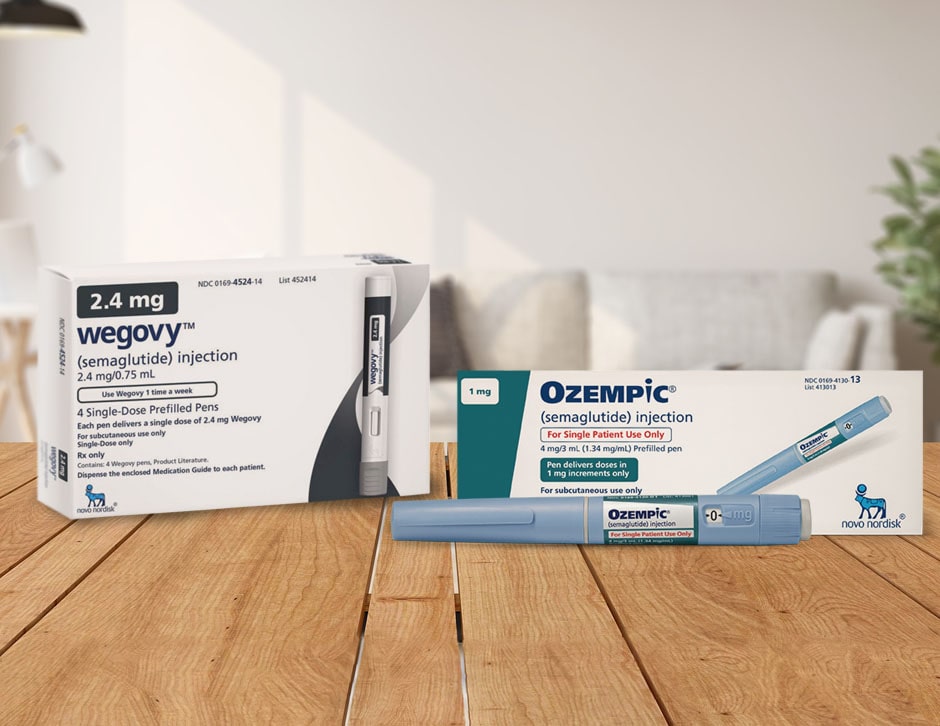Compounded Semaglutide + B12 Product Guide
Semaglutide is the active ingredient present in GLP-1 medications. Compounded Semaglutide is compounded from base and not from salts. Compounding of Semaglutide is allowed by the FDA on a temporary basis, while semaglutide-based medications are on the FDA’s shortage list.
The information presented here is only applicable for non-diabetics who have been prescribed Compounded Semaglutide after their AgelessRx prescriber deemed it appropriate.
Quick tips
Here are some simple steps to help you get the most from each dose:
- Refrigerate your vials upon arrival
- Use with a reduced-calorie meal plan & exercise
- Take Compounded Semaglutide on the same day each week
- Can be taken with or without food
- Rotate injection sites every week
- Be sure to properly discard your vials & syringes
Getting started
When you first receive your Compounded Semaglutide, ensure proper storage guidelines to maintain the quality of the solution.
Follow the instructions for properly drawing and administering Compounded Semaglutide.
Always dose according to your doctor-guided titration schedule.
Storage
To maintain the utmost quality, it is best to refrigerate your Compounded Semaglutide vials between 36°F and 46°F. If your vial has been stored below 36°F or above 86°F for an extended time, the solution may become ineffective.
After 28 days, you must discard your vial, even if there is still some solution remaining – this applies to all multi-dose vials (MDVs).
Upon receiving your Compounded Semaglutide, check the temperature of the vials with the back of your hand. If it feels hot to the touch, please contact us immediately.
You may safely travel with your Compounded Semaglutide vials so long as the above conditions are met while traveling. Be sure to travel with a refrigerated case if necessary, and to bring your own sharps disposal container if you will not have access to one.
Drawing and administering Compounded Semaglutide
How to draw your solution
Before your first use, take the time to review how to properly draw your solution.
Next, ensure that you are drawing the correct amount of solution according to your titration schedule. Your current dose will always be displayed on your vial – use this as a reminder before you begin.
It is important to sterilize the top of the vial with an alcohol wipe each time before drawing up the solution.
How to measure units on your syringe
If you’re new to subcutaneous injections, follow this quick guide to understand the measurements on your syringe.
Your weekly doses are measured in milliliters (ml) to units. Before getting started, check to see how many units are in your weekly dose.
The label on your subcutaneous syringe shows units. Each unit represents 0.01ml, so every 10 units represents 0.1ml.
Each small line on the syringe represents 1 unit, and each large line represents 10 units. So, if your dose calls for 20 units, simply draw your solution up to the line that reads “20.”
If your weekly dose calls for a measurement not clearly labeled on the syringe (like 25 units), pay close attention to the markers between the large lines when drawing up your dose. There may be even smaller measurement lines on the syringe that are more difficult to see. Count these carefully as you draw up your dose to ensure the most accurate measurement.
How to administer your solution
Compounded Semaglutide is delivered via subcutaneous injection, which means that you will inject the solution into a fatty layer of tissue, such as your abdomen or the back of your arm. If you’re new to self-administered injections, take the time to review how to properly administer your injection before proceeding.
As a general rule, you should grip the syringe with your dominant hand, and grasp the injection site with the other hand.
If you can grasp at least 2 inches of skin, then deliver the injection at a 90° angle (or, straight in). If you cannot grasp at least 2 inches of skin, deliver the injection at a 45° angle.
To avoid irritation, try switching injection sites each week. You can take Compounded Semaglutide with or without food, and at any time of day, but try to be as consistent as possible to ensure the best outcomes.
After you have administered your injection, discard the needle and syringe in an FDA-approved sharps container. Never reuse the needle or the syringe once it has been used.
Compounded Semaglutide titration schedule
Compounded Semaglutide is always prescribed with a doctor-guided titration schedule to gradually introduce the medication to your body. This way, you have the best opportunity to experience the greatest benefits possible while reducing side effects.
Compounded Semaglutide follows a standardized titration protocol that is similar to that of other GLP-1 treatments, but with an added titration dose at Month 4, designed to help users more smoothly transition to the maximum dose.
California and New York protocol
Unless you are specifically prescribed otherwise, California and New York patients who are prescribed Compounded Semaglutide + B12 will follow the titration schedule as follows:
| Week | Dose/Units | Vial Size/Strength | Frequency |
|---|---|---|---|
| Weeks 1-4 | 0.25mg (5 units) | 2ml / 5mg/0.4ml | Once weekly |
| Weeks 5-8 | 0.5mg (10 units) | 2ml / 5mg/0.4ml | Once weekly |
| Weeks 9-12 | 1mg (20 units) | 2ml / 5mg/0.4ml | Once weekly |
| Weeks 13-16 | 1.5mg (30 units) | 2ml / 5mg/0.4ml | Once weekly |
| Weeks 17-19 | 2mg (40 units) | 2ml / 5mg/0.4ml | Once weekly |
| Weeks 20+ | 2.5mg (50 units) | 2ml / 5mg/0.4ml | Once weekly |
Your prescribed dose may differ from the standard titration plan listed above. Always follow the titration schedule provided by your AgelessRx prescriber, even if it differs from the standard titration protocol above.
If you forget your titration schedule, you can always check your Rx bottle or your AgelessRx portal.
If you miss taking Compounded Semaglutide on your scheduled day, you can still take your dose whenever you can, so long as it’s within 5 days of the missed dose. You can then resume your normal dosing schedule. If more than 5 days have elapsed, skip this dose and take it on your next normally scheduled day. Never double up on doses if you missed one the previous week.
Common side effects
Compounded Semaglutide has not been evaluated by the FDA, but semaglutide-based medications reviewed by the FDA have the following side effects: nausea, vomiting, diarrhea, stomach pain, and constipation. These normally go away on their own within a few days, or up to 2-3 weeks.
A common side effect of any weight loss strategy is fatigue and muscle loss, which may occur as a result of less food intake. As a result, the body has less energy from food (fatigue) and begins pulling energy from reserves stored in fat and muscle (muscle loss).
If you do experience fatigue, rest assured that it should go away on its own as your body adjusts to the medication and changes in your diet.
Maintaining muscle mass requires a careful balance of diet, exercise, and protein intake. Try to eat a moderate amount of protein every day without over-consuming, and exercise at least 3-5 times per week, or 150 minutes per week.
Dehydration may also be an indirect side effect of Compounded Semaglutide for those experiencing vomiting and diarrhea. If you do experience these side effects, make sure that you are drinking plenty of water and fluids with electrolytes to avoid dehydration.
For some patients, taking probiotics may help reduce gastrointestinal side effects, but results may vary.
To help prevent side effects from occurring or persisting, try the following:
- Eat slower & at more regular intervals throughout the day
- Try to take Compounded Semaglutide at about the same time of day each week
- Drink only water or clear, unsweetened beverages
- Avoid fried, greasy foods in favor of healthier, low-fat options
This is only a summary of potential side effects and how to address them. For more information, please reference the Mayo Clinic’s semaglutide resources, or ask your prescriber.
Serious side effects
Semaglutide use has been associated with the following rare but serious effects:
- Thyroid C-cell Tumors
- Diabetic Retinopathy
- Hypoglycemia
- Kidney problems
- Gallbladder problems
- Pancreatitis
- Worsening of Mood
For a full list of potential warning signs for these conditions, please reference the Mayo Clinic’s semaglutide resources.
Important safety information
Compounded Semaglutide should not be used by anyone who has a personal or family history of medullary thyroid carcinoma (MTC) or multiple endocrine neoplasia syndrome 2 (MEN2).
Do not use Compounded Semaglutide if you are pregnant, breastfeeding, or planning to become pregnant or breastfeed. If you become pregnant while taking Compounded Semaglutide, consult your prescriber before continuing with your next dose.
Though rare, allergic reactions to semaglutide are still possible. If you notice any shortness of breath or swelling around your face, tongue, or throat after using Compounded Semaglutide, stop use and contact emergency services right away. Mild allergic reactions around the injection site are normal and not cause for emergency.
As with any prescription medication, the dose prescribed is for you and you alone. Do not, under any circumstances, allow anyone else to use your Compounded Semaglutide.
FAQs
Is Compounded Semaglutide safe?
Compounded Semaglutide is made in an FDA-registered compounding pharmacy. Further, we have ensured that all formulations will only be compounded from semaglutide base, rather than its salt-based counterparts. Our partner pharmacies will continue to uphold our same standards of excellence for this and all other products, so that you can have the best outcomes possible.
How does Compounded Semaglutide work?
Semaglutide falls into a category of medications known as GLP-1 receptor agonists (GLP-1 RAs), which imitate the GLP-1 hormone to reduce the amount of glucose delivered into the bloodstream and encourage more insulin production from your pancreas. GLP-1 RAs also act on the digestive system to delay gastric emptying, thereby delaying the release of food from the stomach, and modulate brain activity to suppress appetite.
Semaglutide is the active ingredient in GLP-1 medications such as Ozempic® and Wegovy®. As such, Compounded Semaglutide is presumed to follow a comparable mechanism of action as these medications.*
*Compounded Semaglutide has not been FDA approved for weight loss, but its compounding is temporarily allowed by the FDA as a short-term alternative due to the ongoing semaglutide shortage.
Additional resources
-

How Peppermint Oil Can Reduce Your Semaglutide GI Symptoms
The side effects of Semaglutide are often mild and go away on their own. But peppermint oil can help reduce discomfort as your body adjusts to the medication.
-

Wegovy® vs. Ozempic®: Why Isn’t Ozempic® FDA Approved for Weight Loss?
What’s the difference between Ozempic® and Wegovy®? Why do they both have separate FDA approvals? We answer these questions and more!
-

How to Titrate with Ozempic®
Titrating with Ozempic® is slightly different than with Wegovy®, but nothing you can’t handle! Check out this quick guide to get you started with your Ozempic® titration schedule.
